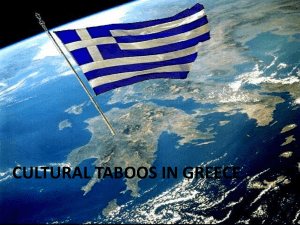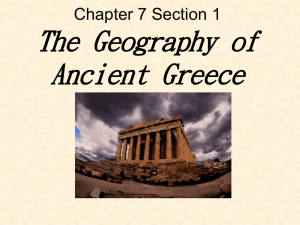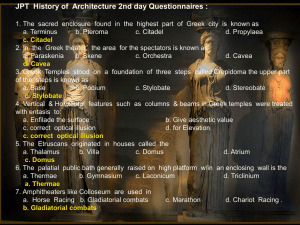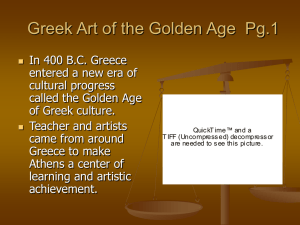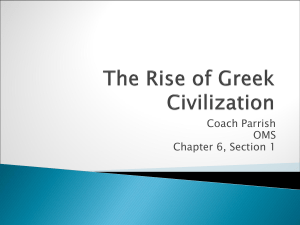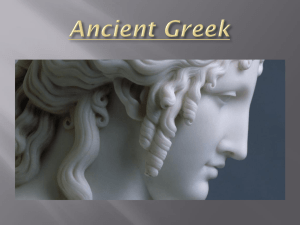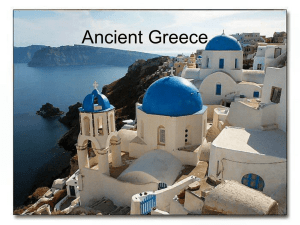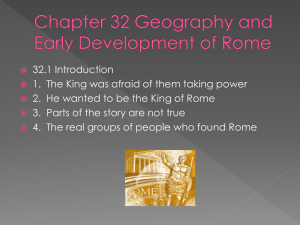(Greek Architecture).
advertisement
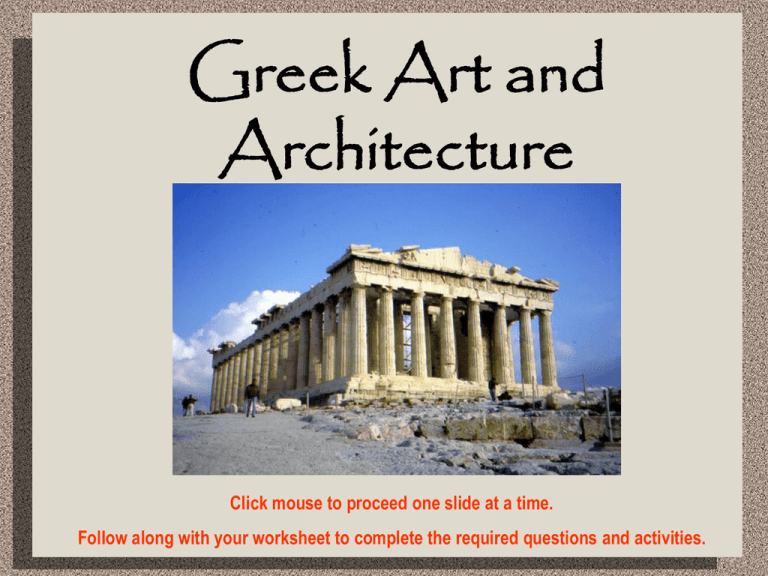
Greek Art and Architecture Click mouse to proceed one slide at a time. Follow along with your worksheet to complete the required questions and activities. Architecture of Ancient Greece Greek life was dominated by religion and so it is not surprising that the temples of ancient Greece built to honor their gods were the biggest and most beautiful. They also had a political purpose as they were often built to celebrate civic power and pride, or to offer thanksgiving to the patron deity of a city for success in war. Complete questions 1 and 2 of Part A (Greek Architecture) in your worksheet. Then sketch the examples of the Ionic Orders in question 3. Make sure that you look for the three types of orders in the visuals to follow on the next slides. Look for examples of all three types. Greek Orders The Greeks developed three architectural systems, called orders, each with their own distinctive proportions and detailing. The Greek orders are: Doric, Ionic, and Corinthian. The Doric style is rather sturdy and its top (the capital), is plain. This style was used in mainland Greece and the colonies in southern Italy and Sicily. The Ionic style is thinner and more elegant. Its capital is decorated with a scroll-like design (a volute). This style was found in eastern Greece and the islands. The Corinthian style is seldom used in the Greek world, but often seen on Roman temples. Its capital is very elaborate and decorated with acanthus leaves. Greek Orders The Parthenon Built as a temple of Athena Parthenos ("Virgin") in the Doric Style, the Greek goddess of wisdom on the Acropolis in Athens. The Parthenon was built in the 5th century BC, and despite the enormous damage it has sustained over the centuries, it still communicates the ideals of order and harmony for which Greek architecture is known. Can you identify what Greek order was utilized? Temple of Erechtheum A temple from the middle classical period of Greek art and architecture, built on the Acropolis of Athens between 421 and 405BC. Can you identify what Greek order was utilized? The Erechtheum contained sanctuaries to Athena Polias, Poseidon, and Erechtheus. From the body of the building porticoes project on east, north, and south sides. The eastern portico, using the Ionic style, gave access to the shrine of Athena, which was separated by a partition from the western portion. The southern portico, known as the “Porch of the Maidens” from the six sculptured draped female figures that support it, is the temple's most striking feature. The Temple of Apollo The Greeks built the Temple of Apollo at Didyma, Turkey (about 300 BC). The design of the temple was known as dipteral, a term that refers to the two sets of columns surrounding the interior section. These columns surrounded a small chamber that housed the statue of Apollo. With columns reaching 64 ft high, these ruins suggest the former grandeur of the ancient temple. Can you identify what Greek order was utilized? A remarkable feature of this temple is the use of all three Greek Orders— Doric outside and Ionic and Corinthian within. Most of the building is of a hard, fine-grained grey limestone, but marble was used for the sculptures and the more decorative parts, including the ceilings. The temple has other peculiarities. It faces north, instead of east (as did its predecessor) and the statue of Apollo was placed in an adyton, or inner sanctuary. The Temple of Zeus at Athens The most ornate of the classic orders of architecture, Corinthian was also the latest, not arriving at full development until the middle of the 4th cent. B.C. The oldest known example, however, is found in the temple of Apollo at Bassae (c.420 B.C.). The Greeks made little use of the order. The temple of Zeus at Athens (started in the 2nd century B.C. and completed by Emperor Hadrian in the 2nd century A.D.) was perhaps the most notable of the Corinthian temples. Can you identify what Greek order was utilized? Finish up question 3 in Part A (Greek Architecture). Right mouse click , previous to return to previous slides on Greek architecture. Are you ready to start Greek Art?? Okay, here we go…. Jewelry of Ancient Greece The beginnings of Greek jewelry can be traced back to remote prehistory. Masterpieces of exceptional workmanship and finesse have been found in Crete and on other Aegean islands where the Minoan civilization flourished. To this day Greek silver- and goldsmiths draw creative inspiration from Homer's remarkable descriptions of Achilles' shield, of Aphrodite's girdle, of the gold door knobs in the palace at Troy. Jewelry of Ancient Greece In antiquity jewelry also accompanied man after life; being deposited with the dead along with other personal objects, which is why many pieces are found in excavations of graves. Many of the traditions of the ancient Greeks were adopted by Christianity, such as the custom of dedicating jewelry to the gods in order to thank them or to seek their protection. This custom lived on in the new religion in the form of votive offerings, whereas that of burying man together with his beloved possessions died out. The use of jewelry as amulets continued too: the coins of the founders of Byzantium, Constantine the Great and his mother Helen, were worn as phylacteries, as was the cross, paramount symbol of the Christian faith. Jewelry of Ancient Greece The great changes that mark the Hellenistic age (330-27 BC),.initiated by the conquests of Alexander the Great and increased contacts with the East and Egypt, affected the art of jewelry too. Not only is the abundance of gold astonishing but also the creation of new types of jewelry and the introduction of other decorative themes. A new style was achieved by using semi-precious and even precious stones, such as chalcedony, cornelian, amethyst, rock crystal and principally garnets. An important type of earring appeared around 330 BC and predominated in Hellenistic and early Roman times: the hoop with finial in the form of heads of animals, maenads, negroes or of a full figure of Eros and other devices. Complete question 1 of Part B (Greek Art). Done yet?? If so, let’s move on to something for which the Greeks will always be remembered… Greek Sculpture. Sculpture of Ancient Greece Greeks portrayed the gods in very similar fashion as they did the regular humans. There were no distinctions of size or body make up in their sculpture which would suggest that the gods where greater or more powerful than the humans. This is also similar in Greek stories, where the gods are shown to have very human characteristics, both good and bad. The Greeks were blessed with a large supply of marble, which was what they used most in their sculptures. Bronze was also used in their artistic work of humans. There are three main periods of Greek Sculpture; Archaic, Classical and Hellenistic. Sculpture of Ancient Greece The Archaic period was the earliest period in Greek Sculpture which started around 600 B.C. and lasted until 480 B.C. These works have a stiff and ridged appearance similar to that of the Egyptian sculpture. The second period, the Classical period, was between the Archaic and Hellenistic times. The Classical period shows a very large shift from the stiff Archaic to a more realistic and sometimes idealistic portrayal of the human figure. Females, after the 5th century B.C., were depicted nude, often with flowing robes. The robes gave the sculpture the idea of movement and realism in an effort by the artist to show humans more realistically. The third period, the Hellenistic period, started a little before 300 B.C. To the average person, it is more difficult to see the distinctions between the Classical and Hellenistic period. Both periods did the majority of their sculpture as nudes. The Greeks portrayed a young, vigorous, and athletic person in their works. These works idealized the individual and in a way, attempted to capture the idea of youth and strength in their design. The works reflect the commonly held views of youth, strength, and courage which were encouraged in the Greek City states. Complete question 2 of Part B (Greek Sculpture). Now that we understand the periods of Greek sculpture, let’s take a look at some. Please select two of the following three sculptures to analyze. Art of Ancient Greece Discobolos c. 450 BC Roman marble copy after the bronze original by Myron height 155 cm (61 in) Museo Nazionale Romano, Rome Select two of the three sculptures and complete art analysis exercise on your worksheet Art of Ancient Greece The "Agamemnon" Mask Gold, from Tomb V at Mycenae Sixteenth century BC National Archeological Museum, Athens Select two of the three sculptures and complete art analysis exercise on your worksheet Art of Ancient Greece Venus de Milo Parian marble, h 2.02 m (6 1/2 ft) Found at Milo 130-120 BC Musee du Louvre, Paris Select two of the three sculptures and complete art analysis exercise on your worksheet You should now be finished with your entire worksheet. We hope you have enjoyed this brief tour of Greek Art and Architecture. We hope to see you again soon!

